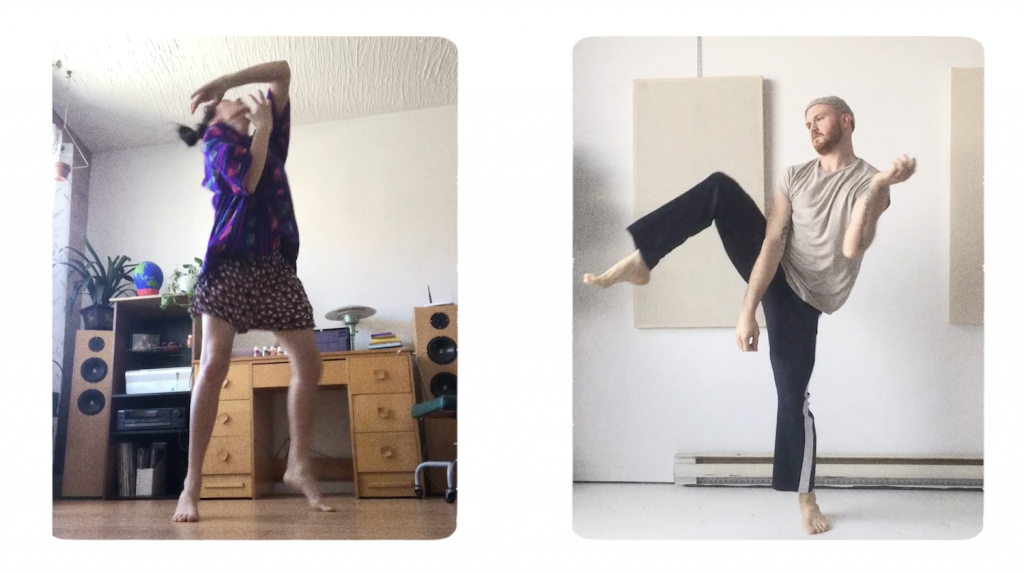A Guide to Safe Virtual Dance Classes

Message québécois de la JID 2020 © RQD
This guide is intended for teachers and participants in home-based virtual dance classes. Its aim is to offer suggestions for improving and supporting dance training in a safe and friendly environment.
In virtual classes, the meeting between the student and the teacher no longer takes place in a neutral and adapted studio space. The home changes its function to become a practice space, and it must be safely adapted to this new reality.
Please note that the CNESST does not cover home-based training for participants, hence the importance of taking preventive measures to ensure the dancers’ safety.
(Updated on January 26, 2021)
A guide designed to evolve with your expertise
Home-based dance training in a virtual environment is a new reality. To ensure that this guide reflects these rapidly evolving practice conditions, we invite you to contribute to its continuous updating by sharing your experience as a teacher or as a participant.
Access the Google Docs version of the guide at any time to comment, provide further details, or share your tricks and tips for the benefit of the entire community.
1. PREPARATION
TEACHER
Pedagogy
- Create an alternative class format adapted to the home and not only the studio. If possible, prepare variations for the exercises. Take into consideration the limited and variable space in which each student can work (and your own space): shape of the room, dimensions, flooring, light, etc.
- Choose simple, easy-to-remember sequences (that students can remember from class to class) that do not take up too much of space. Also, consider creating progressive exercises that can be modified over the course of the sessions to gradually increase their level of difficulty.
- Present the lesson plan for each session in advance so that participants can prepare their space and their bodies safely.
- Specify whether your class requires specific objects, accessories, clothing or footwear and hairstyles.
Space
- Set aside time before and after each class to organize and properly set up your teaching space.
- Consider decluttering your space by removing picture frames from the walls or moving any other objects likely to make the on-screen image too busy for students.
- Ask your students how much space they have available in their home.
- Determine a minimum space requirement (measurements) and communicate it to the participants in advance. It is advisable to try out your class yourself in advance, while observing the minimum required space.
- Specify whether your class requires a particular surface. Is it possible to do the class on a carpet or on a non-resilient flooring?
- Suggest that the students keep a yoga mat within reach. The mat can help absorb the impact during certain jumps and other movements on the floor.
- Control your practice space, if required (animals, roommates). Notify the occupants of the dwelling about the time and duration of the class. You can post a sign on your door to make sure no one enters the room during the class.
Technology
- In order to provide quality teaching in a safe environment, access to an excellent Internet connection with at least 40 Mbps download / 10 Mbps upload is recommended to ensure good visual and sound quality.
- Make sure participants can see you on the screen if a demonstration is necessary for your course. Proper camera framing and lighting are important. Avoid backlighting.
- If your camera has autofocus, test it before your class to make sure the image is not blurry (mainly during movements).
- Do not forget to test the required sound volume (voice and music) and check if it will disturb those around you. Ask the people in your home to limit sound disruptions during your class, for example by putting their cell phones on vibrate mode.
- Prioritize laptop or tablet over phone for greater participant observation. You can also use the Chromecast option to project your image onto a larger television screen.
- Consider whether a maximum number of participants is necessary in order to see everyone and allow for feedback.
Physical and emotional safety
- Your voice is often your main teaching tool in a virtual learning environment. To reduce vocal fatigue, consider using a microphone to amplify your voice.
- Keep outside distractions to a minimum. You are responsible for observing what is happening on screen and taking action in case of emergency, even at a distance. It is important to get a list of emergency contacts, especially if some of your students are home alone during the course of your class.
- Pay close attention to the emotional health of your participants, particularly in the virtual learning environment required due to the pandemic. Practice compassion and positive reinforcement, and don’t hesitate to refer a participant to a competent mental health resource, if you feel there’s a need for it.
- Be understanding. Students may have to reconcile virtual dance learning at home with a challenging family situation beyond their control.
PARTICIPANT
- Read all materials sent by the teacher such as the class plan, required clothing and hairstyle, accessories to have on hand, etc.
- Set aside time before and after each class to properly organize your practice space and equipment.
- Prepare your practice space based on the spatial requirements expressed by your teacher. If there are corner edges on furniture or other elements you risk coming into contact with, please move them out of the way or find a way to cushion them.
- Keep a yoga mat ready for use. It could serve as a cushioned practice surface for certain jumps or other movements on the floor and thus compensate for the absence of a resilient floor.
- Control your practice space, if necessary (animals, roommates). Notify the occupants of the dwelling about the time and duration of the class. For example, you can post a sign on your door to make sure no one enters the room during the class.
- A good Internet connection (at least 40 Mbps upload / 10 Mbps download) is recommended for a better virtual experience in relation to the image and the sound.
- Test your devices before class and make sure you have downloaded the necessary programs.
- Prioritize laptop or tablet over phone for greater class observation. You can also use the Chromecast option to project your image onto a larger television screen.
- Make sure the teacher can see you on the screen at all times so that they can safely guide you. Proper camera framing and lighting are important. Avoid backlighting.
2. STEPS
TEACHER
Before the class
- Make sure all the participants can see and hear you.
- Take attendance (and keep the emergency contact numbers with you).
- Check the physical and mental condition of the participants. Ask if there are any injuries to report or any difficulties focusing.
- Determine whether or not the participants have CNESST coverage in case of injury during the virtual class.
- Read and share on-screen a legal notice stating that you are not responsible in case of injury, along with a note concerning copyright (music, protected syllabus, etc.).
- Share the class plan.
- Remind the participants about the space and accessories required.
During the class
- Ask the participants to be mindful of their movements within the space. Encourage them to adapt to their environment, make adjustments, and stay alert during exercises to avoid collisions. Prepare and suggest alternatives.
- Encourage the participants to regularly look away from the screen to avoid cervical tension and bring their attention back to their space and what they feel (listen and be attentive).
- Be specific and systematic in your verbal instructions in order to support and guide the participants’ physical practice. Don’t hesitate to provide plenty of detail and to repeat certain instructions. Be positive and encouraging in your comments.
- Check if the framing needs to change based on the exercises so that you can safely observe and guide the participants.
- Schedule a water break every 30 minutes (or more frequently if needed). You can’t control the heat in the participants’ homes. Also, short breaks will help the student stay focused on the screen longer.
- End the class by thanking the participants.
PARTICIPANT
- Be aware of and attentive to your physical and spatial limitations. For example, listen to your sensations, adjust to the space, reduce the range or pace of your movements if you feel pain or fatigue, etc.
- Stay connected to your personal progress. Do more if your physical abilities and/or space permit it.
- If the chosen teaching method involves formal presentation, please don’t hesitate to observe your colleagues on-screen if you have any doubts about the execution of a movement.
- Keep a notebook handy. You may find it helpful to write down the corrections you receive in order to review them before the next class. You can also write down some details about the exercises to help you remember them.
- Be aware and attentive to your ability to concentrate when using the screen. For example, avoid staring at your screen all the time, move your neck, etc.
- Make sure the required class materials are within reach (water, accessories, etc.) and read the class plan if you receive it in advance.
- Don’t hesitate to ask questions and request guidance from the teacher to make sure that you understand the instructions.
3. POST-MORTEM
TEACHER
- Ask the participants questions or send an anonymous survey to get feedback on your class (e.g. Were the participants’ respective practice spaces safe for the class?).
PARTICIPANT
- Share any comments that could allow the teacher to improve their virtual teaching practice.
- If a teacher suggests a survey, take the time to complete it and share your feedback.
4. RESOURCES
Zoom for dance teachers (video) https://www.youtube.com/watch?v=rW3U2Fv2CY8
Teaching Dance live Online, How to Prep and Transition – Audra Allen Dance LLC http://www.danceworksacademy.ca/uploads/5/5/9/9/55996439/how_to_teach_dance_online_workbook.pdf
5 Tips for Making Online Classes Work for You – Dance Teacher https://www.dance-teacher.com/5-tips-for-making-online-classes-work-for-you-2645788591.html
How to teach dancing online (and make money doing it) – The Home of Happy Feet https://thehomeofhappyfeet.com/how-to-teach-dancing-online-and-make-money-doing-it/
Expert committee:
– Clara Furey
– Laurie-Anne Langis
– Alexandre Morin
– Marie Mougeolle
– Isabelle Poirier
– Alisia Pobega
– Marie-Joanie Raymond
– Jamie Wright
Writing:
– Laurie-Anne Langis
– Isabelle Poirier
– Amélie Lévesque Demers
Revision:
– Coralie Muroni
Coordination:
– Daniel Bastien

This publication was made possible thanks to financial assistance provided under the Commission des partenaires du marché du travail’s Programme d’actions concertées pour le maintien en emploi (PACME).
A Guide to Safe Virtual Dance Classes
© 2021 Regroupement québécois de la danse

